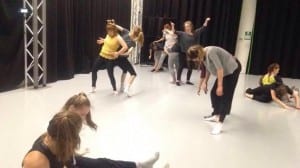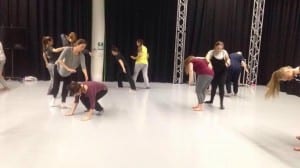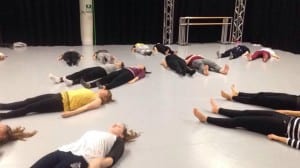“In Contact improvisation, one finds oneself in circumstances that demand accessing support from any area of one’s own body surface, in physical contact with any area of another person’s body surface, both of which are in motion. In this situation one is not able to rely on habits, the reflexes take over and the rest is history” (Lepkoff, 2008) This, to me, is important to realise that within contact improvisation habitual movement struggles to take over your body whilst you’re in motion with another body. I have noticed this within my own practice, straying far from habitual movement with other bodies, however, my journey in and out of the contact jam and in-between finding different bodies to work with tends to stray back to habitual movement.
“In order to change habitual movement patterns one needed to address the functioning of the whole organism, the mind as well as the body” (Lepkoff, 1999)
This is something that I feel I need to make the connection between whilst working on my own improvisation and I believe it’s an important thing to master.
In this week’s session we started to look at different ways to move across other bodies using surfing and the idea of over and under dancer to get across the space, whilst keeping the connection at the torso/hips.
At the start, I noticed that the movement was difficult to keep the movement flowing, as I kept moving through the space I noticed this was because the connection kept breaking between the two bodies.
What surfaces of the skin needed to make contact? How was the two parts of the body supposed to stay in contact?
I started to think of the bodies moving more as a jigsaw piece rather than two separate parts of the body and releasing myself more into the space of the body.
Looking at different ways to weight bare through surfing and the over and under dancer, using table top and keeping the connection and lifting whilst your partner was acting as the over dancer, become extremely difficult. If felt odd within my body. How was my partner supposed to know when I wanted to roll?
How was I supposed to move myself into table top without hurting my partner?
These are questions I still haven’t answered within my own body as of yet and questions I want to explore within the next contact session and the next jam.
We started to explore ways of weight baring to use in the improve jams.
I realised that momentum was a key part of weight baring lifts, using this to move both bodies, and the more momentum I built the more the movement felt comfortable, it flowed better and the two bodies released a lot more into each other.
I learnt that throughout any weight baring lifts I attempt to do, I must always focus on ‘going down to go up’ and finding different anchors within your body.I started to use the top of my back/shoulders as an anchor.
Being able to release into my partner was fine, however I struggled with being lifted and I noticed within myself that I offered to be the base more than I offered to be lifted. This is something to do with my previous training as always being the ‘base’, it’s something I need to focus on and work with, within jam’s and other weight baring exercises, until I combat my fear of being lifted.
I started to learn throughout most of the exercise we were going through during the session that, trust, confidence, momentum and ‘safe’ practice, are the most important things during weight baring lifts.
For example, the pulling exercise, if the momentum and trust wasn’t there between the two bodies, the exercise wouldn’t work, finding the balance of these between two bodies is so important.
I notice that in the wrap around leg kick lift, momentum and making sure the two bodies fit as a jigsaw piece, this is something me and my partner struggled to grasp, on getting the bodies in the correct places so they fit together, and having the momentum to get us round, it took us quite a while to get the hang of this.
This exercise is something I want to explore further within the contact jam next week.
Contact Jam
This week’s jam felt good, I felt I explored a lot with the movement we learnt the week before and some weight baring lifts, however I struggled to intertwine a lot of the weight baring lifts as I didn’t know how to place them and to initiate them with the other bodies in the space.
I’m starting to focus more on having a connection and conversation with my partner during the jam’s, to make the movement work between us.
Within myself I need to learnt to accept when something doesn’t work and don’t try and force movement upon my partner, instead let the movement flow and see where the two bodies end up.
Sometimes the most amazing movements start from an accidental movement.
Bibliography
Daniel Lepkoff (1999) What is release technique?. [online] Available fromhttp://www.daniellepkoff.com/Writings/What%20is%20Release.php[Accessed 30th October 2016].
Daniel Lepkoff (2008) Contact Improvisation: A Question?. [online] Available from http://www.daniellepkoff.com/Writings/CI%20A%20question.php [Accessed 30th October 2016]



